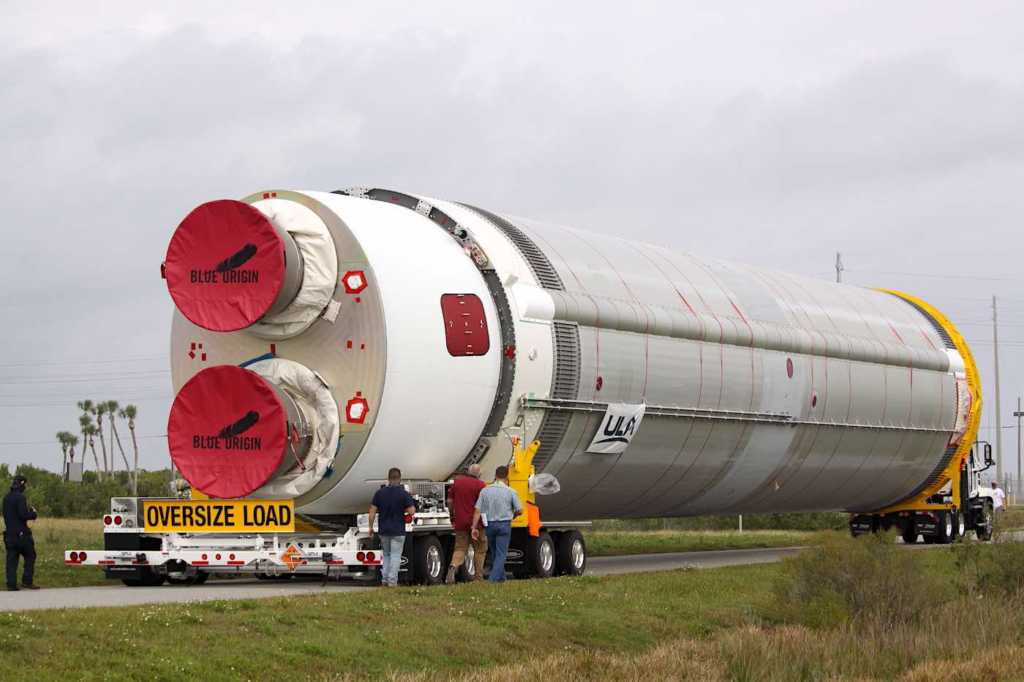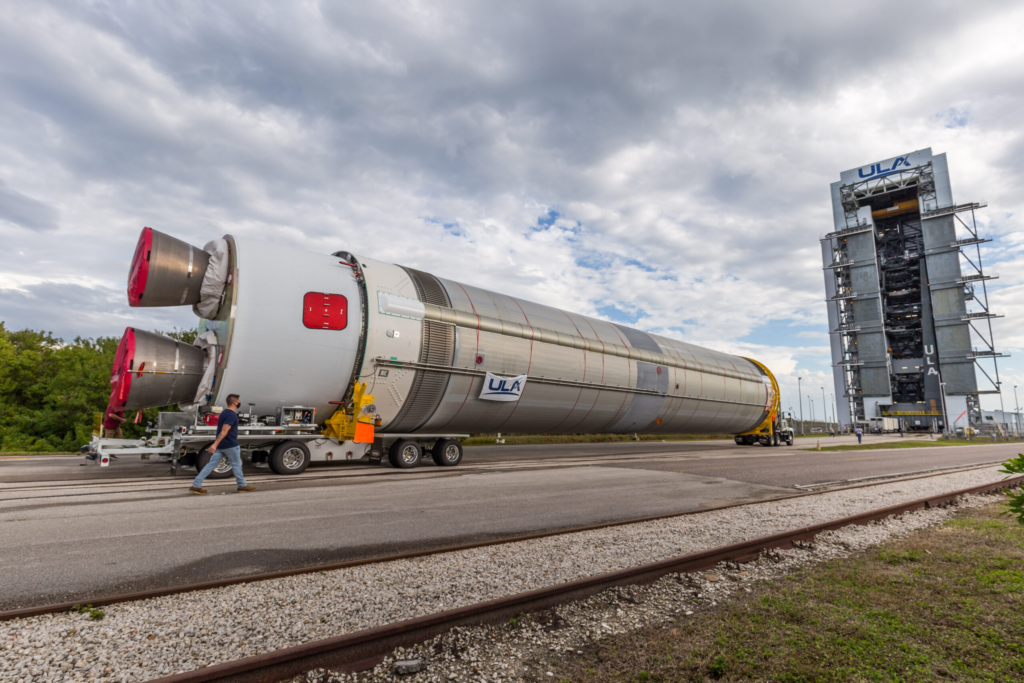
Blue Origin’s Final BE-4 Engine Is About To Be Delivered
Blue Origin has been working on its next-generation BE-4 engine for many years now. Throughout its development and testing there have been some delays pushing back its completion and application to multiple future launch vehicles. This being said, recently the company has been making some significant progress and are just about ready to test these engines for the first time on an official launch.
Only a few weeks ago we saw the delivery of one BE-4 flight engine to United Launch Alliance’s rocket factory in Decatur. Already installed on the rocket, the company only requires one more for its first Vulcan flight scheduled only months away. Fortunately, just yesterday ULA CEO Tory Bruno provided an update on the second flight engine and its expected delivery.
Specifically, he showed off some full duration testing of the flight engine and an estimate of when it should be delivered. This is very big news as once this engine is delivered, ULA will have practically everything they need for final testing and the first launch. Here I will go more in-depth into the recent update, the upcoming launch using BE-4, what to expect in the future, and more.
The Last BE-4 Needed

Earlier this month we saw the first flight engine from Blue Origin delivered to United Launch Alliance. In relation to this, most recently on October 17th, Tory Bruno tweeted saying, “That is a beautiful sight! One more BE4 and he’s off to the Cape.” Here you could see Vulcan with one BE-4 already installed just days after being delivered. Thankfully, Tory just revealed more information on that final engine needed. Specifically, yesterday Tory Bruno tweeted saying, “Sorry about the delay. Twitter just could not handle a full 4 1/2 min of this much sheer rocket glory. I had to edit it down. Here’s the final Acceptance Test trim run for the @blueorigin#BE4 FE1 engine, shortly on its way to join its twin in Decatur.”
This is very significant news as it confirms that this specific engine is operating as expected and should be sent over to the factory for installation very soon. Based on the fact that this specific engine test was a bit ago and Tory saying it will soon join its twin in Decatur, we can expect to see this engine delivered likely within a week or two. In the past few months, we have been provided various updates on both of these engines as they went through both the development and testing process. For example, back in July of this year, Tory Bruno tweeted saying, “Wow. You guys really do like seeing rocket engines. OK, Flight Engine #1 (fully assembled) on the left. #2 (almost done) on the right.” This included an image of the two flight engines that by now are fully complete and almost both delivered.
As of right now, Flight Engine #2 has already been delivered to ULA and is installed on Vulcan. The recent update from Tory shows Flight Engine #1. While in the past Flight Engine #1 was in lead in terms of development, it had to be sent back to Kent for an unspecified issue to be corrected. This error lead to Flight Engine #2 taking the lead and being delivered first. Either way, the first flight engine seems to be working great now and is about to be delivered. This engine is one of the most powerful liquefied natural gas (LNG) fueled rocket engines ever developed. Using an oxygen-rich staged combustion cycle, BE-4 is capable of producing 2,400 kN (550,000 lbf) thrust with deep throttle capability. In terms of its design, Blue Origin highlights that BE-4 was made from the beginning to be a medium-performing version of a high-performance architecture. It’s a conscious design choice made to lower development risk while attempting to meet performance, schedule, and reusability requirements. The company’s hardware-rich approach, multiple developmental units, and redundant test stands enable a high test tempo and rapid learning. All of which will be put to the test for the first time very soon.
First BE-4 Launch

Now that we know more about the specific flight engines that ULA needs and when the last engine should be delivered, we can take a closer look at this launch and why it’s so important for BE-4. Currently, United Launch Alliance is officially targeting the first quarter of 2023 for Vulcan’s maiden flight. This launch is very important for Blue Origin because the Vulcan rocket relies on two BE-4 engines on its first stage for the majority of its thrust. In just months from now, we can expect to watch the BE-4 engine’s first ever launch attempt. This test will provide a lot of invaluable information for the company as they continue to develop the engine. However, if something were to go wrong during the launch relating to these engines, it could be a major setback for the company and the BE-4 program as they go back to the drawing board and figure out exactly what went wrong. On the other hand, if the launch goes perfectly it could help reinforce BE-4’s capabilities and give Blue Origin the confidence to speed up the production of these engines.
Taking a closer look at this upcoming launch, ULA recently released more information on what to expect and some of the final preparation being made. Right now they are nearing completion of the development of the next-generation Vulcan Centaur launch vehicle. “We could not be more excited to be this close to seeing Vulcan lift off on its inaugural flight,” said Tory Bruno. “Vulcan’s high energy design coupled with innovative technology provides one scalable system for all missions and will transform the future of space launch.” They pointed out that once at the Cape, Vulcan will undergo a final series of tests to verify its readiness for flight consisting of multiple tanking tests and a wet dress rehearsal, culminating in flight readiness firing in December, which will be the final step prior to launch. Following the successful final testing, Astrobotic and the other payloads will be installed on the launch vehicle. “This has been an incredible journey to get to this point and I am so proud of the development team,” said Bruno. “We look forward to the first flight as Vulcan offers all customers higher performance and greater affordability while continuing to deliver our unmatched reliability.”
The two LNG BE-4 engines on Vulcan’s first stage will produce over half a million pounds of thrust at sea level during the launch. Blue Origin chose LNG because it is highly efficient, low cost and widely available. Also, unlike kerosene, LNG can be used to self-pressurize its tank. Known as autogenous repressurization, this eliminates the need for costly and complex systems that draw on Earth’s scarce helium reserves. The company points out that LNG also possesses clean combustion characteristics even at low throttle, simplifying engine reuse compared to kerosene fuels.
However, these engines will not be the only things helping lift the Vulcan Centaur. Earlier this month Tory Bruno tweeted saying, “As requested by all of the cool and fun loving space people: “unboxing” of a @NorthropGrumman GEM63XL solid rocket motor at the Cape for the #VulcanRocket in all of its 63 in dia, 120ft glory.” Specifically, Vulcan integrates up to six Northrop Grumman Graphite Epoxy Motor (GEM) 63XL Solid Rocket Boosters (SRBs). They are constructed out of a graphite-epoxy composite with the throttle profile designed into the propellant grain. GEM solids supported the Delta II and Delta IV rockets, and the GEM 63 variant has already flown on ULA’s Atlas V rocket. Looking further up the rocket, Vulcan will rely on two RL10C engines to power its second stage. Logging an impressive record of nearly 400 successful flights and nearly 700 firings in space, RL10 engines, manufactured by Aerojet Rocketdyne, harness the power of high-energy liquid hydrogen. The RL10 boasts a precision control system and restart capability to accurately place payloads into orbit.
The company points out that access to orbit remains a critical hurdle for many missions. However, ULA is working to provide flexible and cost-effective multi-manifest solutions to overcome this barrier. With multi-manifest, two or more spacecraft are integrated on a launch vehicle using available performance and volume margin that would otherwise go unused — optimizing mass to orbit and enabling missions. Multi-Manifest on a Vulcan rocket provides a highly reliable and schedule certain launch solution for spacecraft ranging from CubeSats to small sats and beyond. Combine this with its first stage engines and configurable core stage boosters, and you have a very unique launch vehicle meant to become ULA’s future workhorse. While the BE-4 engine has had some ups and downs throughout its long history, right now it’s closer than ever to a very important milestone. The company has continued to work on the engine for many months and is trying to ensure they deliver ULA with a fully capable next generation engine.
Conclusion
Blue Origin has been developing and testing the BE-4 engine for many years now. This year especially we have seen an increase in this process as they try their hardest to deliver United Launch Alliance with two flight-ready engines. As of right now, this launch and important test is scheduled just a few months away in the first quarter of 2023. We will have to wait and see how it progresses and the impact it has on the space industry.
